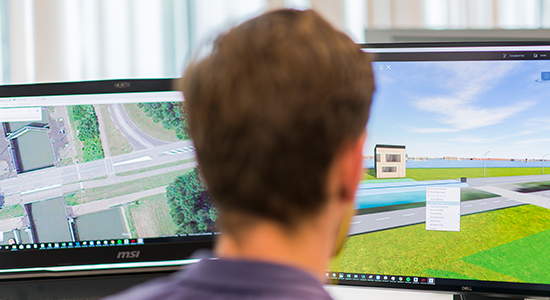Johan Kuppens, CEO Infranea, about how do they transform the world of infrastructure.
For years, digital engineers at Infranea have been using advanced software to digitise design details. This creates tremendous potential in terms of 3D-design, BIM-services and VR-simulation. However, ‘digital engineering’ is so much more than that. What does this mean for Infranea, what are the customer benefits and what does the future hold? An inspiring discussion with Johan Kuppens, the founder of Infranea.
1980s: From 2D to 3D
Computerised design has been around for almost 50 years now, but until recently engineers still needed to ‘click’ each and every design action into the computer. With the rise of 3D-design software in the mid-eighties, Johan Kuppens saw the potential to drastically change what was still a very traditional approach to design and building processes. Back then, there were few computer-aided applications in the infrastructure world. In fact, it turned out to be a tremendous opportunity. “All of a sudden we went from drawing in 2D to modelling in 3D. This was a revolution in our industry”, Johan remembers. As an example, he quotes a large infrastructure project in Antwerp, where originally 20 computers with AutoCAD were provided for the design team. “Infranea got the job done with a handful of 3D designers! The 20 computers never showed up, nor did the 20 drafstmen (laughs).”
From computer-aided to computer-controlled
Over the last 30 years, software has come on in leaps and bounds. Being a pioneer in BIM, Infranea has gained in-depth expertise in BIM applications over the past decade. Even so, BIM is actually only a method to improve the design process. Fundamentally, it changes nothing in the way we design. The founder of Infranea now senses the same revolutionary potential from back then in the evolution towards computer-controlled design. “The shift from computer-aided to computer-controlled is the beginning of a new era for engineering practices”, confirms Johan. As recently described by Yuval Noah Harari in his bestseller ‘21 lessons for the 21st century’, algorithms appear in just about every aspect of our lives and in all that we do. And that’s even before considering AI. Johan puts this into the context of infrastructure: “This means that the design intent is no longer communicated by drawing 2D geometry or modelling 3D objects, but instead by scripting and programming algorithms. The ultimate challenge for engineers is to make these algorithms intelligent. That certainly also applies to designing complex infrastructure”, he adds. “We can now reinvent the engineering profession, like we did in the 1980s, and the transformation will be even more disruptive”.
“Algorithms unleash the raw processing power of computers. This revolution from computer-aided to computer-controlled designs will have a fundamental impact on design practices.”
Infranea as a breeding ground for digital engineers
Infranea did not consciously decide to focus on digital engineering, but everything inevitably headed in that direction. “Digital engineering is in our DNA, so it was an obvious course to take”, says Johan. It all starts with his motto: ‘Everything can be improved’. With this he refers to what he describes as ‘the soul of engineering’. “In this search for continuous improvement, engineers also become programmers, and designing also becomes programming”, says Johan. However, this does not mean that engineers will be replaced by programmers in the coming years. On the contrary, engineers themselves will learn how to programme and to use their engineering abilities to make infrastructure better and above all smarter. “We are therefore consciously cultivating this digital-engineering attitude here in the office. This means, for example, that everyone gets the chance to learn programming and also to put it into practice.” Infranea aims to play a pioneering role in the market like a real network organisation, talking to everyone that shares a passion for digital engineering. Putting the motto ‘All can better’ into practice organically, along with all stakeholders that share the common goal. This summarises the vision of the founder of Infranea to contribute to the digital transformation of the infrastructure sector.

Johan Kuppens – CEO Infranea
What are the benefits of digital engineering for customers?
Johan Kuppens summarises the advantages of digital engineering in three keywords: quality, productivity and integrality. He describes the precise meaning of each word.
- More quality
Thanks to digital engineering many more design variants and optimisations can be tested, whereby the design is bound to better suit the requirements of the customer and end user.
- More productivity
Thanks to digital engineering and the principles of Systems Engineering we can create lots more designs much faster. One digital engineer can do the work of two or three traditional engineers. This is not only a cost saving, at a time when engineers are scarce, but also a boost to efficiency. Indeed, the need for coordination reduces dramatically with less designers involved. This efficiency benefit also frees up more time during, or ideally before the start of the project, to do our homework really well on matters of strategy, prerequisites, criteria, collaboration,… A decent plan of action during the preparation phase is a powerful lever when executing the design. However, the costs then come before the benefits and the customer must accept this.
- More comprehensiveness
Thanks to digital engineering we can transcend all design disciplines. We are no longer dependent on an inadequate exchange of information between the different software packages. Digital engineers are now able to programme these data exchanges themselves, on a project-specific basis, in order to make software really communicate with one another. Therefore, you are not dependent on standard exchange formats and software suppliers. Take a tunnel project for example. Thanks to parametric design and integration scripts, designs from all technical disciplines – civil, structural and technical installations – can all be integrated within a single model. This means there is far less need for clash controls, because the dependencies and interface requirements are directly integrated in the design script. Prevention is always better than cure!
What does the future hold for digital engineers?
Engineers remain essential in the development of good solutions. But, they must now also partly become programmers, as explained above. “Furthermore, soft skills such as collaboration, communication and negotiation will become more important than ever”, confirms Johan. “This is clearly a task for Infranea, as an employer, so these are the skills in which we continue to invest.”
Our customers will become more adept at dealing with the process of digital engineering. For example, this means taking sufficient time at the start to think things through with the digital engineers and only allocating resources and people thereafter. “For example, customers typically ask us to just supply some Revit modellers for a project, but this question should only follow in the second instance. “Start by clearly identifying the goals, scope, stakeholders and the derived process. The time you spend on this is saved several times over by the end of the project,” concludes Johan.
What is digital engineering for Infranea?
Digital engineering is the art of modelling, integrating and optimising design data thanks to digital competencies. It is the evolution from computer-aided to computer-controlled design of infrastructure. A digital engineer is therefore also a bit of a programmer, as well as an engineer. The design logic is explicitly coded in workflows and algorithms. The advantage is that the design process is traceable and repeatable, significantly improving both quality and productivity.
For Infranea, digital engineering consists of applying different digital methods:
- Parametric Design and Generative Design are two examples of Computational Design. In the first method, all principles, design rules, variables and decisions are translated into a script or algorithm. In the second, an auto-adaptive mathematical algorithm imitates nature to organically investigate all possible design solutions, suiting the goals, prerequisites and selection criteria.
- Concurrent Engineering is a method whereby the various sub-processes work as much as possible in parallel, rather than in series. Thanks to this constant interaction and coordination, optimised solutions are reached much more quickly and efficiently. This makes the design process LEAN.
- Integrated BIM provides a connection between non-geometric meta-information, such as requirements and characteristics, and objects in the BIM model. This is an essential prerequisite for achieving an integrated information model.
- Digital Twins are digital replicas of the designed or constructed project, whereby the BIM-model is usually translated into a VR-model. These virtual models are perfect for carrying out all kinds of simulations, validations and trainings. By connecting sensoring data (IoT), a living model is achieved for management and maintenance.
05/04/2020



